A complete step-by-step guide to keyword research using SEMrush
Keyword research is an essential aspect of search engine optimization (SEO) as it helps businesses and website owners understand what their target audience is searching for and how to optimize their content to rank higher in search engine results pages (SERPs).
By identifying the right keywords to target, businesses can ensure that their website is visible to the right people at the right time, resulting in increased website traffic, leads, and ultimately, revenue.
Keyword research also helps in understanding the competition in the industry, what keywords are being used by competitors, and how to differentiate your content and website. This can help businesses to find new opportunities and stay ahead of the competition.
Moreover, keyword research provides insights into the user intent behind a particular search query, which helps in creating the right kind of content that addresses the user’s needs and queries. By understanding the user intent, businesses can create content that is more likely to rank well in search engines and provide value to the user.
Introduction to SEMrush as a tool for keyword research”
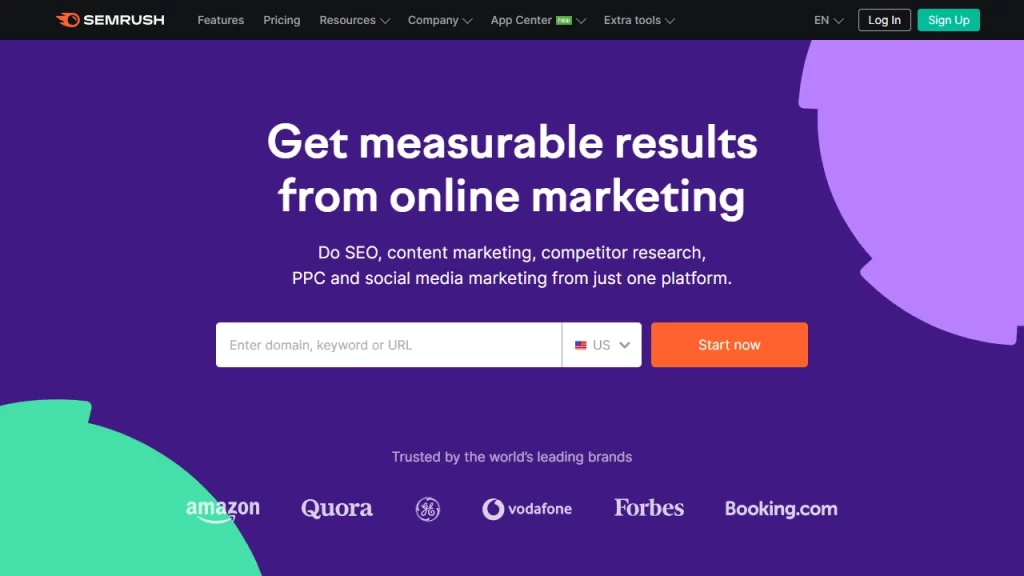
SEMrush is a powerful tool that can be used for a variety of digital marketing and SEO tasks, including keyword research. With SEMrush, businesses and website owners can conduct in-depth research on keywords and phrases related to their industry, analyze the competition, and track their own website’s performance.
Features of SEMrush
One of the main features of SEMrush is the Keyword Magic Tool, which allows users to generate a large list of relevant keywords based on a specific seed keyword or phrase.
The tool also provides important metrics such as search volume, CPC (cost-per-click), and competition level for each keyword, which can be used to evaluate the potential of each keyword and select the best ones to target.
SEMrush also provides a Keyword Overview feature, which allows users to analyze the search trends of a specific keyword over time. This can be used to understand the seasonality of a keyword, as well as its long-term performance.
Also, the Keyword Difficulty Tool allows users to analyze the competition for a specific keyword by providing metrics such as the number of competing websites, their domain authority and backlinks, and the overall difficulty level of ranking for that keyword. This can help businesses to identify keywords that they might have a better chance of ranking for.
Purpose of this SEMrush guide
The purpose of this guide is to provide a comprehensive, step-by-step guide for beginners to conduct keyword research using SEMrush.
The guide is aimed at individuals or businesses who are new to SEO and keyword research and want to learn how to use SEMrush to improve their website’s visibility in search engines.
Throughout the guide, we will cover various aspects of keyword research using SEMrush, including
- setting up a SEMrush account,
- conducting keyword research,
- analyzing the keyword list,
- optimizing your website with the keywords,
- and tracking the performance of the keywords.
By the end of this guide, readers will have a solid understanding of how to use SEMrush for keyword research and how to effectively use the keywords they have researched to improve their website’s visibility in search engines.
Setting up a SEMrush account
In order to use SEMrush, you’ll need to set up an account. There are different plans available, each with different features and pricing options.
The first plan is the Pro plan.
This plan is the most popular among small businesses and bloggers. It includes all the basic features such as the Keyword Magic Tool, Keyword Overview, and Keyword Difficulty Tool. It also includes some advanced features such as historical data, organic traffic insights, and the ability to track up to 10,000 keywords.
The second plan is the Guru plan.
The Guru plan is geared towards digital agencies and small-to-medium-sized businesses. It includes all the features of the Pro plan, as well as additional tools such as the Brand Monitoring tool, Social Media Tracker, and the ability to track up to 30,000 keywords.
The third is the Business plan
This one is the most comprehensive and includes all the features of the Guru plan, as well as additional tools such as the Lead Generation Tool, the Custom Reports tool, and the ability to track up to 50,000 keywords. This plan is best suited for large businesses and agencies.
Finally, there is also a free version of SEMrush which is limited in features, but it’s still a good way to test the tool.
It’s important to note that all plans come with a free trial, so you can test out SEMrush and see which plan is the best fit for your needs before committing to a paid subscription.
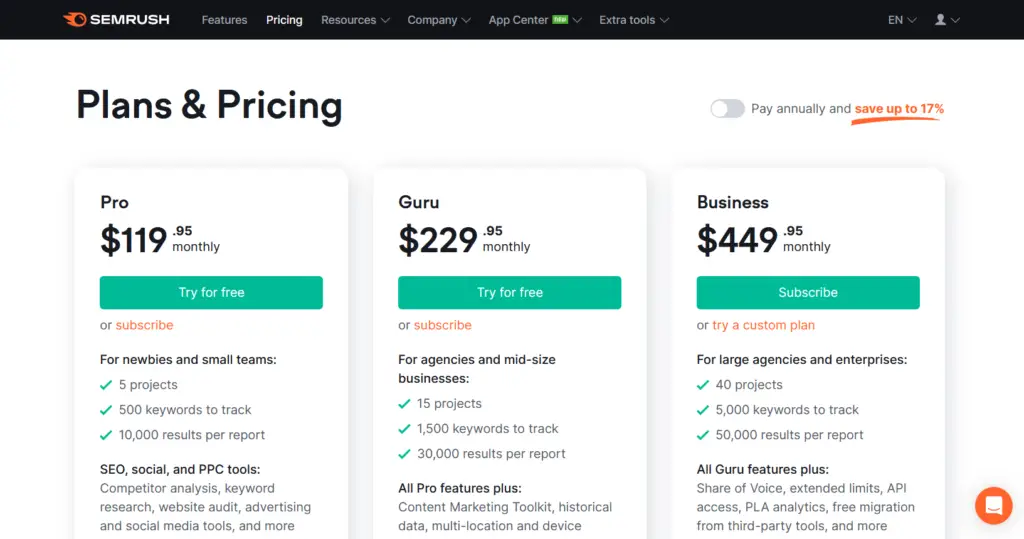
How to create an account and start a free trial
Creating an account and starting a free trial with SEMrush is a straightforward process. Here are the steps to follow:
- Go to the SEMrush website: https://www.semrush.com/
- Click on the “Free Trial” button on the top right corner of the homepage.
- Fill out the registration form with your personal information and create a username and password. (You can also sign up using your Google account)
- Select the plan that you want to try during the free trial period.
- Enter your payment information, and then click the “Start my free trial” button.
It’s worth noting that you will be required to enter a credit card to start the free trial, but you will not be charged until the end of the trial period. Additionally, you can cancel the trial at any time during the trial period without incurring any charges.
Once your account is set up and your free trial has begun, you’ll be able to access all of SEMrush’s features and tools, and you can start using them to conduct keyword research and optimize your website.
If you have any trouble setting up your account, you can contact the SEMrush support team for help. They are available to assist you with any questions or issues you may have.
Walkthrough of the SEMrush interface
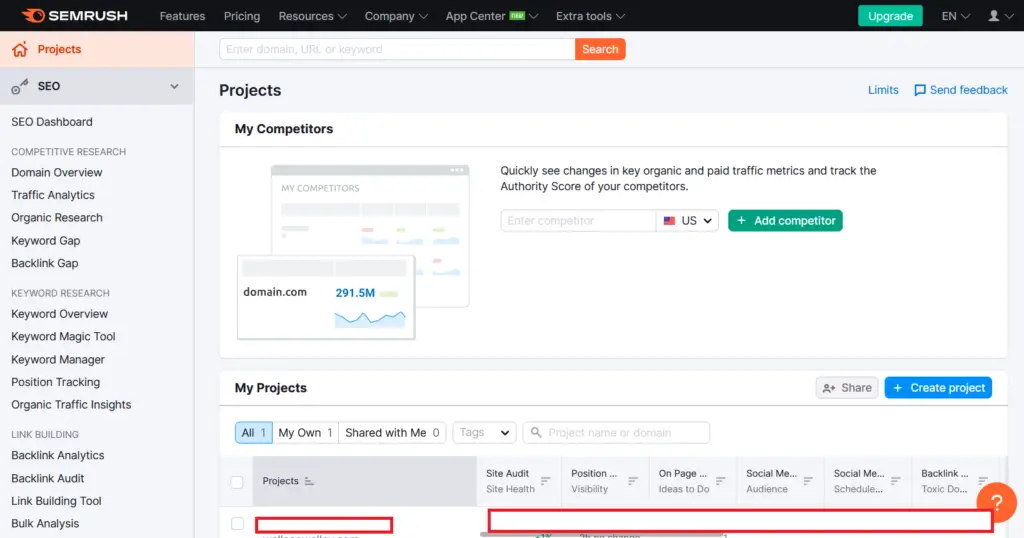
Now that you have set up your SEMrush account and started your free trial, it’s time to familiarize yourself with the SEMrush interface.
The interface is designed to be user-friendly, and it’s easy to navigate. Here’s a quick overview of some of the main features and tools you’ll find in the SEMrush interface:
- The Main Menu: Located at the top of the screen, the main menu provides access to all of SEMrush’s features and tools. You can use it to access the Keyword Magic Tool, Keyword Overview, Keyword Difficulty Tool, and much more.
- The Dashboard: This is the first page you will see when you log in to your SEMrush account. It provides a quick overview of your account’s activity, including the number of keywords you’re tracking, your organic traffic, and a graph of your website’s search engine visibility.
- The Reports section: This section is where you will find detailed analytics and data on your website’s performance, including organic search, paid search, display advertising, and more. You can access pre-set reports or create custom reports according to your needs.
- The Projects section: This section allows you to create and manage different projects for your website. You can use it to track your website’s keyword rankings, backlinks, and organic traffic, and you can also schedule reports to be delivered to your email.
- The Tools section: This section provides access to all of SEMrush’s tools and features, including the Keyword Magic Tool, Keyword Overview, Keyword Difficulty Tool, and more. This is where you’ll spend the most time conducting keyword research and analyzing your website’s performance.
Overall, the SEMrush interface is easy to navigate and provides access to all the tools and features you need to conduct keyword research and optimize your website’s visibility in search engines. The interface provides a lot of information and data, but it’s well-organized and easy to understand.
Conducting Keyword Research
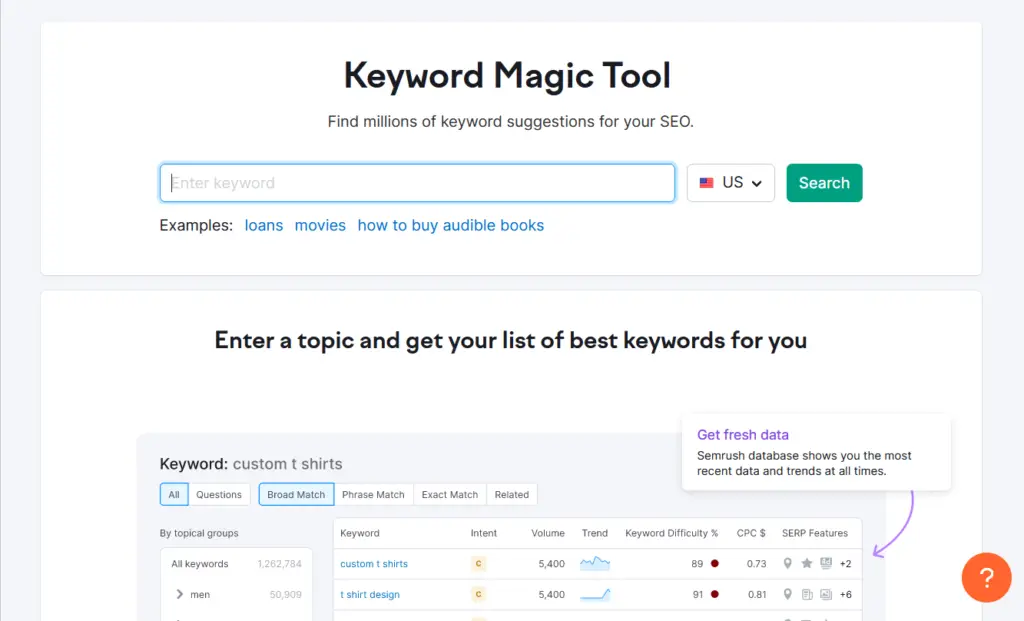
One of the main features of SEMrush is the Keyword Magic Tool, which allows users to generate a large list of relevant keywords based on a specific seed keyword or phrase. The tool is designed to help users identify new keyword opportunities and analyze the competition for specific keywords.
Explanation of the tool and its features
The Keyword Magic Tool is a powerful tool that allows users to generate a list of keywords based on a specific seed keyword or phrase.
The tool provides a wealth of information on each keyword, including the search volume, CPC (cost-per-click), and competition level.
Additionally, it allows you to filter the keywords based on different criteria such as keyword volume, keyword difficulty, CPC, etc.
How to use the tool to generate a list of keywords:
To use the Keyword Magic Tool, you’ll first need to log in to your SEMrush account and navigate to the “Tools” section. Then, select the “Keyword Magic Tool” from the dropdown menu.
Once you’re in the Keyword Magic Tool, you’ll be prompted to enter a seed keyword or phrase. After entering the seed keyword, you can filter the keywords based on different criteria such as keyword volume, keyword difficulty, CPC, etc.
The tool will then generate a list of related keywords that you can use to optimize your website’s visibility in search engines.
It’s worth noting that you can also use the Keyword Magic Tool to find keywords that are related to a specific URL, this is known as “domain” research. This can be useful if you want to analyze your competitors’ keywords.
Using the Keyword Overview:
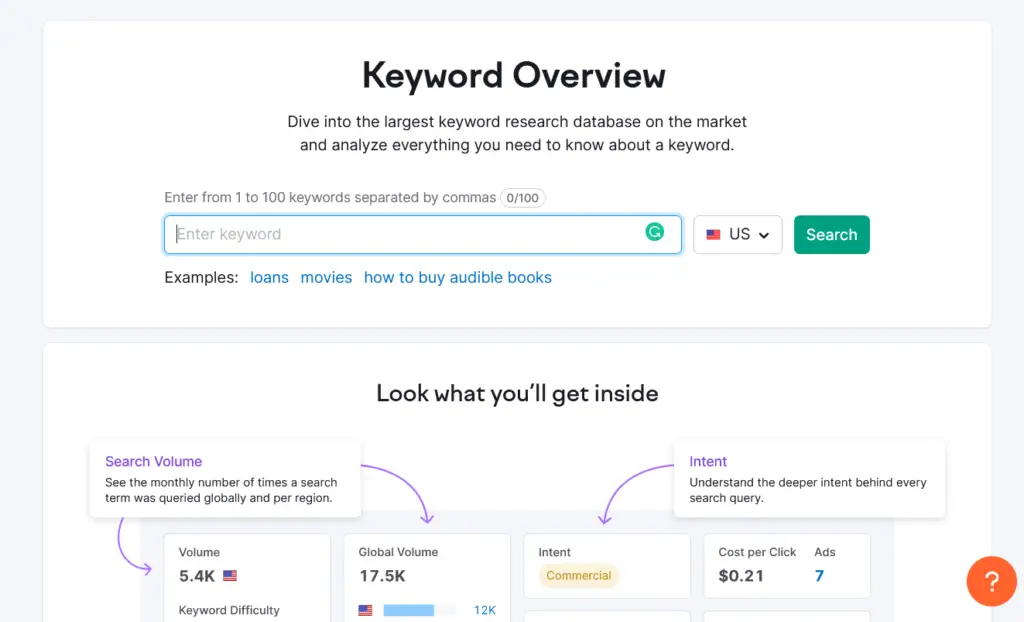
The Keyword Overview tool is another powerful feature of SEMrush that allows users to analyze the search trends of a specific keyword over time. It can be used to understand the seasonality of a keyword, as well as its long-term performance.
Explanation of the tool and its features:
The Keyword Overview tool provides a wealth of information on a specific keyword, including search volume, CPC, competition, and trend data over time.
It also allows you to see the top organic search results for that keyword, as well as the top paid search ads. Additionally, it provides information on the related keywords and related questions.
How to use the tool to analyze the search trends of a specific keyword.
To use the Keyword Overview tool, you’ll first need to log in to your SEMrush account and navigate to the “Tools” section. Then, select “Keyword Overview” from the dropdown menu.
Once you’re in the Keyword Overview tool, you’ll be prompted to enter a keyword that you want to analyze. After entering the keyword, the tool will generate a report that includes information on the keyword’s search volume, CPC, competition, and trend data over time.
You can use this data to understand the seasonality of the keyword and identify any trends or fluctuations in search volume over time.
This information can be used to inform your content creation and marketing strategy. For example, if a keyword has a high search volume in a specific month, you may want to create content related to that keyword during that month.
The Keyword Overview tool can be a valuable tool for understanding the search trends of a specific keyword, it can help you to identify opportunities and adjust your strategy accordingly.
Using the Keyword Difficulty Tool
The Keyword Difficulty Tool is another feature of SEMrush that allows users to analyze the competition for a specific keyword. This tool can help businesses to identify keywords that they might have a better chance of ranking for.
Explanation of the tool and its features
The Keyword Difficulty Tool provides a score from 0 to 100 that indicates the difficulty level of ranking for a specific keyword. The tool also provides metrics such as the number of competing websites, their domain authority and backlinks, and the overall difficulty level of ranking for that keyword.
How to use the tool to analyze the competition for a specific keyword
To use the Keyword Difficulty Tool, you’ll first need to log in to your SEMrush account and navigate to the “Tools” section. Then, select “Keyword Difficulty” from the dropdown menu.
Once you’re in the Keyword Difficulty Tool, you’ll be prompted to enter a keyword that you want to analyze. After entering the keyword, the tool will generate a report that includes a difficulty score, as well as information on the number of competing websites, their domain authority and backlinks, and the overall difficulty level of ranking for that keyword.
You can use this information to identify keywords that are less competitive and may be easier to rank for. The difficulty score can be a helpful guide, as a lower score generally indicates a lower level of competition for that keyword.
Additionally, you can also use this information to identify your competitors and analyze their strategies.
Optimizing Your Website with the Keywords
Once you have conducted keyword research and selected the best keywords to target, the next step is to optimize your website’s content with those keywords.

How to use the keywords in the website content:
There are several ways to use the keywords in your website’s content:
- Meta tags: Use the keywords in the title and meta description tags of your website’s pages. This can help to increase the visibility of your website in search engine results.
- Headings: Use the keywords in the headings and subheadings of your website’s pages. This can help to make your content more readable and increase the chances of the page ranking for those keywords.
- Body content: Use the keywords throughout the body content of your website’s pages. However, it’s important to use them in a natural way, and avoid keyword stuffing, which can have a negative impact on your website’s ranking.
- Alt tags: Use the keywords in the alt tags of your images. This can help to make your images more discoverable in search engines and increase the chances of your website ranking for those keywords.
It’s also important to keep in mind that optimizing your website’s content for search engines is just one aspect of the optimization process. You should also pay attention to other factors such as user experience, loading speed, mobile optimization, etc.
Also, as you optimize your website with the keywords, you should keep track of your website’s performance in search engines, you can use SEMrush or other tools to track your website’s ranking for the keywords you targeted.
Tips for optimizing meta tags and headers with keywords.

Optimizing meta tags and headers with keywords is an important part of on-page SEO, as it can help to increase your website’s visibility in search engine results. Here are some tips for optimizing meta tags and headers with keywords:
- Use keywords in the title tag: The title tag is one of the most important on-page elements for SEO. It should be unique for each page and contain the main keyword for that page. Keep it short and descriptive, and avoid using the same title for multiple pages.
- Use keywords in the meta description: The meta description should provide a brief summary of the page’s content and include the main keyword. Keep it under 155 characters, as this is the maximum length that will be displayed in search engine results.
- Use keywords in the H1 header: The H1 header is the main heading on the page and should contain the main keyword for that page. It should be used only once per page and should be used to introduce the main topic of the page.
- Use keywords in subheadings: Subheadings (H2-H6) should be used to break up the content and help users to scan the page. They should be used to introduce different sections of the page and include relevant keywords.
- Use keywords in the URL: The URL should be short, descriptive, and include the main keyword. Avoid using special characters and keep it simple and readable.
By following these tips, you’ll be able to optimize your meta tags and headers with keywords, which can help to increase your website’s visibility in search engine results.
Remember to keep the user experience in mind and make sure that the meta tags and headers are relevant to the content on the page.
How to track the performance of the keywords using SEMrush.
After you have optimized your website’s content with keywords, it’s important to track the performance of those keywords in order to understand how well your website is performing in search engines and identify areas for improvement.
SEMrush provides several tools that can be used to track the performance of keywords.
- Keyword Tracking: SEMrush’s Keyword Tracking tool allows you to track the performance of specific keywords over time. You can use this tool to monitor your website’s ranking for the keywords you’re targeting and identify any fluctuations in search engine visibility.
- Position Tracking: This tool allows you to track your website’s visibility in search engines for specific keywords. You can use it to see how your website is ranking for the keywords you’re targeting in different search engines and identify areas for improvement.
- Organic Search: The Organic Search report provides detailed analytics on your website’s organic search performance, including the number of organic keywords, organic traffic, and the average position of your website in search engine results.
- Competitor Analysis: SEMrush’s Competitor Analysis tool allows you to analyze the keywords your competitors are ranking for and compare your website’s performance to theirs. This information can be used to identify new keyword opportunities and improve your website’s visibility in search engines.
- Site Audit: This tool can help you to identify technical SEO issues on your website and provide recommendations on how to fix them. It also allows you to monitor your website’s health and detect any issues that could affect your website’s visibility in search engines.
By tracking the performance of your keywords regularly, you’ll be able to make data-driven decisions that can help to improve your website’s visibility in search engines.
Conclusion on how to use SEMrush for keyword research
SEMrush can be used as a powerful tool for generating a list of relevant keywords, analyzing competition and search trends, and tracking the performance of keywords over time.
Keyword research is an essential part of SEO and can help businesses to improve their website’s visibility in search engines. .
To further improve your understanding and skills in keyword research, we suggest the following resources:
- Google’s Keyword Planner: Google’s Keyword Planner is another free tool that can be used to conduct keyword research and get ideas for new keywords.
- The Art of SEO: Mastering Search Engine Optimization” by Eric Enge, Steve Spencer, and others: This book provides a comprehensive guide to SEO and includes a section on keyword research.
Overall, keyword research is an essential part of SEO and SEMrush can be used as a powerful tool to conduct keyword research effectively and efficiently.
By following the steps outlined in this guide, you’ll be able to conduct keyword research, analyze the competition and search trends, and track the performance of your keywords over time.
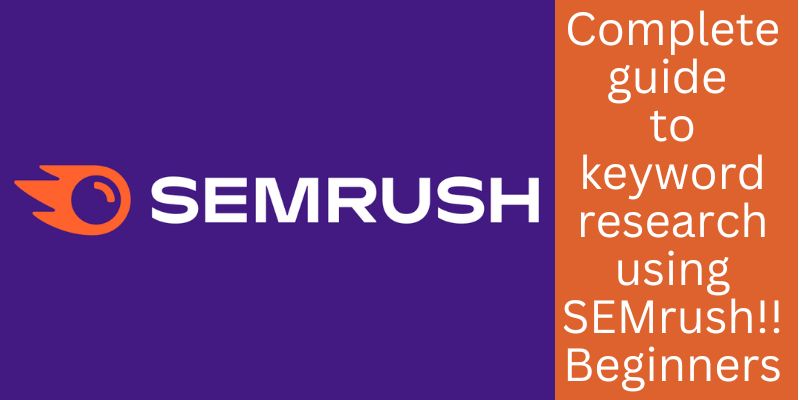
This is a very interesting blog. I love your content and I think I am going to spend a few more time to check it out